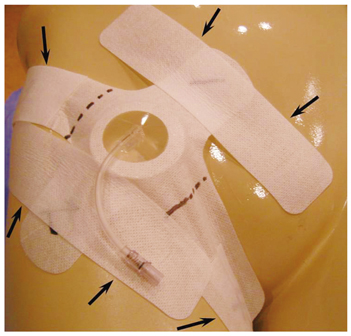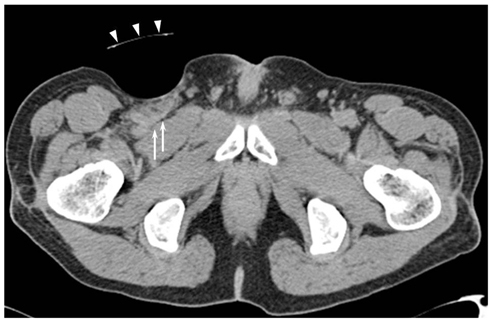Korean J Radiol.
2012 Feb;13(1):61-65. 10.3348/kjr.2012.13.1.61.
A Retrospective Review on Feasibility and Safety of a New Pneumatic Compression Device for Femoral Arteriotomy Hemostasis
- Affiliations
-
- 1Department of Radiology, Chungbuk National University Hospital, Cheongju 361-711, Korea.
- 2Department of Radiology and Center for Imaging Science, Samsung Medical Center, Sungkyunkwan University School of Medicine, Seoul 135-710, Korea. swshin@skku.edu
- KMID: 1058794
- DOI: http://doi.org/10.3348/kjr.2012.13.1.61
Abstract
OBJECTIVE
To report our initial experience on the technical feasibility and safety for hemostasis of a new pneumatic compression device in patients undergoing femoral arteriotomy.
MATERIALS AND METHODS
This study included 40 consecutive patients in whom hemostasis after transfemoral catheterization was readered by using a pneumatic compression device consisting of an inflatable bulb-containing main body and four pieces of supplementary tape. Medical records were retrospectively reviewed for outcomes and complications of hemostasis. Technical success was defined as achieving immediate hemostasis 10 minutes after applying the device over the arteriotomy sites, and clinical success was defined as the ability to ambulate after 4 hours of bed rest without any complications.
RESULTS
Technical and clinical success was achieved in 38 (95%) and 37 (93%) patients, respectively. In two patients, hemostasis was achieved after conversion to manual compression. One patient required sand bag placement after removal of the device to control minimal oozing of blood. No patients had late complications.
CONCLUSION
The new pneumatic compression device provides effective and safe hemostasis after transfemoral catheterization in selected patient populations.
Keyword
MeSH Terms
Figure
Reference
-
1. Madigan JB, Ratnam LA, Belli AM. Arterial closure devices. A review. J Cardiovasc Surg (Torino). 2007. 48:607–624.2. Bent CL, Kyriakides C, Matson M. Femoral artery stenosis following percutaneous closure using a starclose closure device. Cardiovasc Intervent Radiol. 2008. 31:814–816.3. Brueck M, Bandorski D, Rauber K, Boening A. Percutaneous transluminal dilatation of inadvertent partial or complete occlusion of the femoral artery caused by Angio-Seal deployment for puncture site closure after cardiac catheterization. J Invasive Cardiol. 2010. 22:353–357.4. Cooper CL, Miller A. Infectious complications related to the use of the angio-seal hemostatic puncture closure device. Catheter Cardiovasc Interv. 1999. 48:301–303.5. Jang JJ, Kim M, Gray B, Bacharach JM, Olin JW. Claudication secondary to Perclose use after percutaneous procedures. Catheter Cardiovasc Interv. 2006. 67:687–695.6. Kim YJ, Yoon HK, Ko GY, Shin JH, Sung KB. Percutaneous transluminal angioplasty of suture-mediated closure device-related femoral artery stenosis or occlusive disease. Br J Radiol. 2009. 82:486–490.7. Stone PA, Campbell JE, Andrews KH, Bates MC. Posterior wall capture and resultant common femoral occlusion complicating StarClose access closure. J Vasc Surg. 2008. 48:469–471.8. Dangas G, Mehran R, Kokolis S, Feldman D, Satler LF, Pichard AD, et al. Vascular complications after percutaneous coronary interventions following hemostasis with manual compression versus arteriotomy closure devices. J Am Coll Cardiol. 2001. 38:638–641.9. Koreny M, Riedmuller E, Nikfardjam M, Siostrzonek P, Mullner M. Arterial puncture closing devices compared with standard manual compression after cardiac catheterization: systematic review and meta-analysis. JAMA. 2004. 291:350–357.10. Chamberlin JR, Lardi AB, McKeever LS, Wang MH, Ramadurai G, Grunenwald P, et al. Use of vascular sealing devices (VasoSeal and Perclose) versus assisted manual compression (Femostop) in transcatheter coronary interventions requiring abciximab (ReoPro). Catheter Cardiovasc Interv. 1999. 47:143–147. discussion 148.11. Jaspers L, Benit E. Immediate sheath removal after PCI using a Femostop is feasible and safe. Results of a registry. Acta Cardiol. 2003. 58:535–537.12. Juergens CP, Leung DY, Crozier JA, Wong AM, Robinson JT, Lo S, et al. Patient tolerance and resource utilization associated with an arterial closure versus an external compression device after percutaneous coronary intervention. Catheter Cardiovasc Interv. 2004. 63:166–170.13. Kunert M, Gremmler B, Schleiting H, Ulbricht LJ. Use of FemoStop system for arterial puncture site closure after coronary angioplasty. J Invasive Cardiol. 2004. 16:240–242.14. Brown DB, Gould JE, Gervais DA, Goldberg SN, Murthy R, Millward SF, et al. Transcatheter therapy for hepatic malignancy: standardization of terminology and reporting criteria. J Vasc Interv Radiol. 2009. 20:S425–S434.15. Walker SB, Cleary S, Higgins M. Comparison of the FemoStop device and manual pressure in reducing groin puncture site complications following coronary angioplasty and coronary stent placement. Int J Nurs Pract. 2001. 7:366–375.16. Khaghany K, Al-Ali F, Spigelmoyer T, Pimentel R, Wharton K. Efficacy and safety of the perclose closer s device after neurointerventional procedures: prospective study and literature review. AJNR Am J Neuroradiol. 2005. 26:1420–1424.17. Assali AR, Sdringola S, Moustapha A, Ghani M, Salloum J, Schroth G, et al. Outcome of access site in patients treated with platelet glycoprotein IIb/IIIa inhibitors in the era of closure devices. Catheter Cardiovasc Interv. 2003. 58:1–5.18. Warren BS, Warren SG, Miller SD. Predictors of complications and learning curve using the Angio-Seal closure device following interventional and diagnostic catheterization. Catheter Cardiovasc Interv. 1999. 48:162–166.19. Balzer JO, Scheinert D, Diebold T, Haufe M, Vogl TJ, Biamino G. Postinterventional transcutaneous suture of femoral artery access sites in patients with peripheral arterial occlusive disease: a study of 930 patients. Catheter Cardiovasc Interv. 2001. 53:174–181.20. Dauerman HL, Applegate RJ, Cohen DJ. Vascular closure devices: the second decade. J Am Coll Cardiol. 2007. 50:1617–1626.21. Kim HY, Choo SW, Roh HG, Han H, Kim SS, Lee JY, et al. Efficacy of femoral vascular closure devices in patients treated with anticoagulant, abciximab or thrombolytics during percutaneous endovascular procedures. Korean J Radiol. 2006. 7:35–40.22. Wada H, Usui M, Sakuragawa N. Hemostatic abnormalities and liver diseases. Semin Thromb Hemost. 2008. 34:772–778.
- Full Text Links
- Actions
-
Cited
- CITED
-
- Close
- Share
- Similar articles
-
- Hemostatic Efficacy and Safety of a Novel Mechanical Compression Device for Femoral Arteriotomy
- Surgical Treatment of Acute Arterial Occlusion after Applying the Vascular Closure Device for Hemostasis of Femoral Arteriotomy in Vascular Intervention
- Delayed Vascular Claudication Following Diagnostic Cerebral Angiography: A Rare Complication of the AngioSeal Arteriotomy Closure Device
- Could real-time ultrasonography guidance be useful for the effective deployment of FemoSeal in common femoral arteriotomy?
- Common Peroneal Nerve Palsy by the Use of Intermittent Pneumatic Compression Device after Hartmann's Operation



